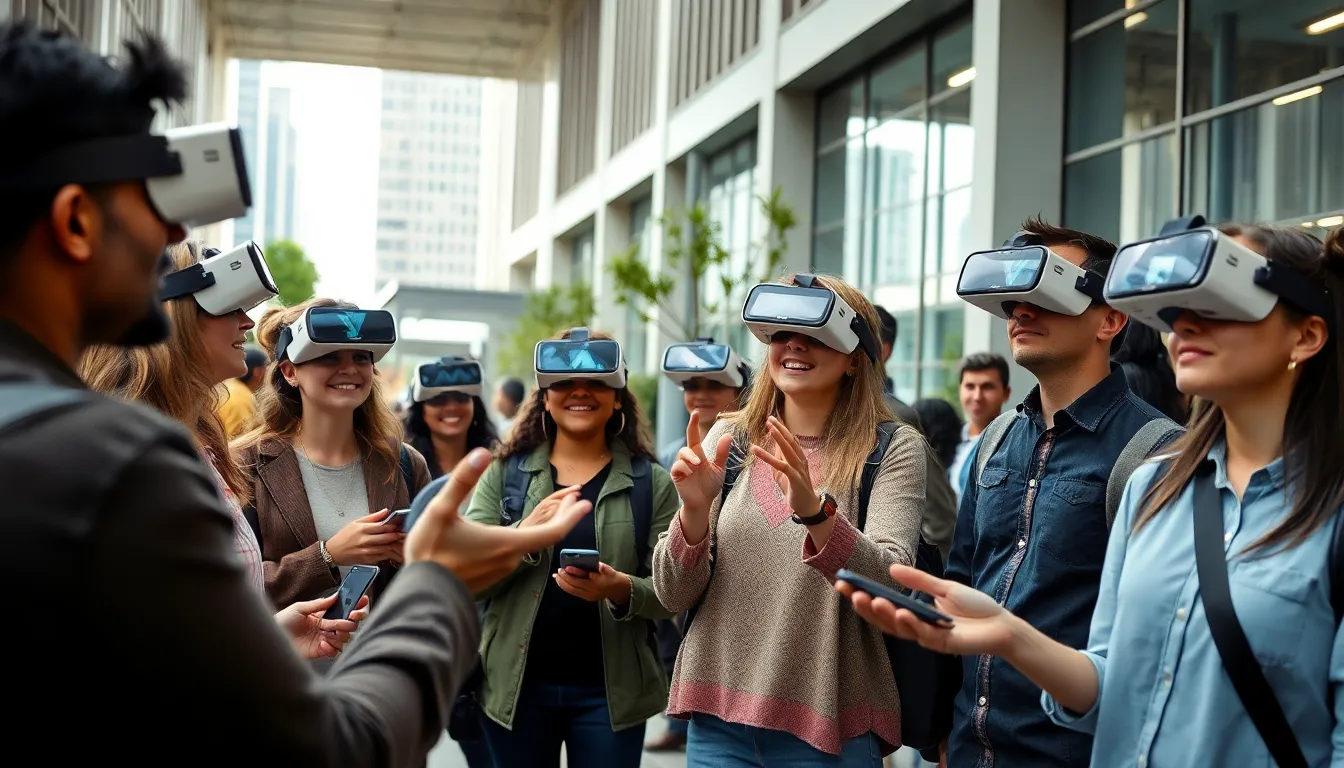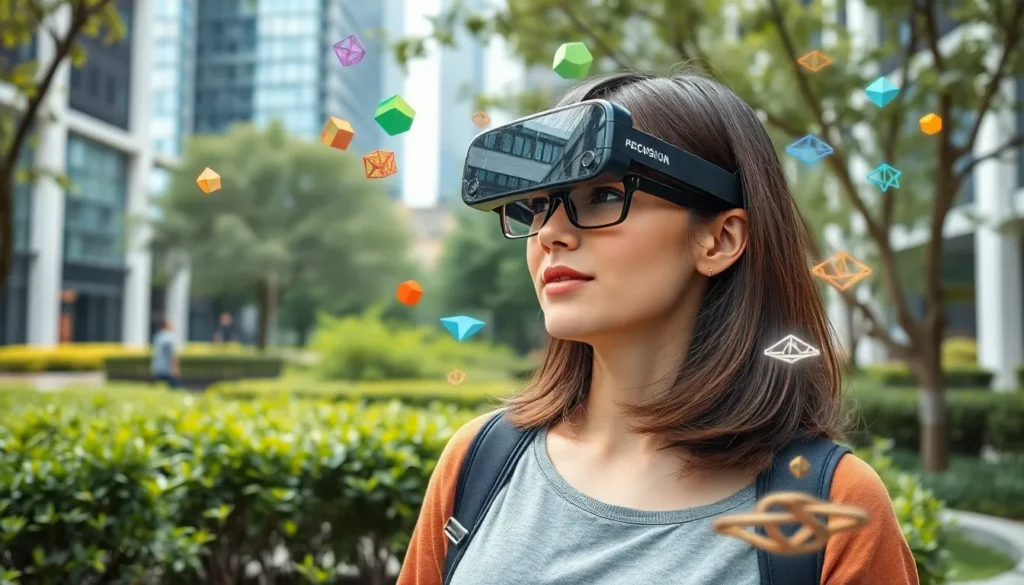Table of Contents
ToggleIn a world where creativity meets technology, augmented reality (AR) is the new playground for innovators. Imagine blending the real and digital realms, where your wildest ideas come to life right before your eyes. It’s not just about fancy glasses or apps; it’s about unleashing a wave of imagination that can transform everyday experiences into extraordinary adventures.
Understanding AR Technology
Augmented reality technology superimposes digital information onto the real world. It utilizes devices such as smartphones, tablets, and AR glasses to enhance user experiences. Users engage with 3D models, animations, and texts while interacting with their surroundings.
Familiarity with AR components elevates creative possibilities. The software consists of a variety of development tools and platforms, enabling creators to design engaging content. Popular platforms include Unity and ARKit, which provide essential frameworks for creating AR applications.
Hardware plays a crucial role in AR effectiveness. Devices equipped with advanced sensors and cameras capture environmental data in real time. These features facilitate accurate mapping and user interaction, enriching the AR experience.
Understanding the application of AR spans multiple fields. Education benefits through interactive learning tools that make abstract concepts tangible. Retail utilizes AR for virtual try-ons and product demonstrations, enhancing customer engagement.
User interfaces significantly impact the success of AR experiences. Design simplicity ensures ease of use and intuitive navigation. Creating compelling visuals captures user interest, making the experience memorable and enjoyable.
Adoption of AR technology relies on internet connectivity. Strong and stable connections allow for seamless integration of digital content and real-world environments. Offline capabilities emerge as a valuable feature, providing users access without constant internet access.
Comprehending AR technology encompasses its components, applications, interfaces, and connectivity. This knowledge empowers creators to enhance their imaginative work, unlocking new avenues for creativity and innovation.
The Importance of Creativity in AR

Creativity serves as a driving force in augmented reality (AR), enhancing user experiences and fostering innovation. With AR, users connect imaginative concepts with real-world environments.
Creative Applications of AR
Interactive storytelling flourishes through AR, allowing users to engage with narratives in immersive ways. Healthcare benefits from AR applications that visualize complex information, making education more interactive. Retail environments utilize AR for virtual try-ons, blending convenience with customer engagement. Educational settings leverage AR tools, transforming traditional learning methods into engaging experiences. Architecture and design also find new dimensions, helping clients visualize projects before actual construction.
Case Studies of Successful AR Projects
IKEA Place utilizes AR to help customers visualize furniture within their homes before purchase. Pokémon GO merged the gaming world with reality, creating a global phenomenon and increasing physical activity. Snapchat features AR filters that extend social interaction, enhancing user creativity. The OREO Dive project engaged consumers through AR experiences, allowing them to unlock unique content by scanning cookies. These examples showcase how creativity in AR translates into successful, engaging applications.
Techniques to Enhance AR Creativity
Enhancing creativity in augmented reality involves utilizing effective techniques that stimulate innovation. Implementing specific strategies can significantly improve the quality of AR experiences.
Collaborative Tools for AR Development
Collaboration tools streamline the AR development process. Platforms like Github and Slack facilitate communication among team members. By using shared virtual workspaces, developers and designers can exchange ideas and feedback in real time. Project management software such as Trello helps teams organize tasks and deadlines efficiently. Additionally, cloud-based tools allow for easy storage and access to assets like 3D models. Engaging in open-source projects promotes learning and sharing best practices within the AR community. These collaborative efforts lead to a more dynamic creative environment, enhancing the overall quality of AR applications.
Innovative Design Principles
Innovative design principles elevate AR creativity. Prioritizing user experience ensures intuitive navigation and interaction. Emphasizing simplicity in design minimizes cognitive overload, allowing users to focus on key elements. Incorporating layers of interactivity keeps users engaged and encourages exploration within the AR environment. Integrating storytelling techniques can make experiences relatable and memorable. Using color theory and effective typography enhances visual appeal and conveys information efficiently. Applying these design principles fosters creativity and encourages the development of compelling AR applications.
Future Trends in AR Creativity
Emerging trends in AR creativity focus on enhancing interactivity and immersion. Advances in artificial intelligence (AI) integrate seamlessly with AR, allowing for more personalized experiences. Developers can create adaptive environments that respond to user behaviors, enhancing engagement levels.
In the realm of education, AR’s potential continues to expand, offering interactive learning experiences that adapt to individual learning styles. Immersive simulations provide students with hands-on opportunities, making complex subjects more accessible.
Healthcare also stands to benefit from AR creativity, with visualizations improving diagnostics and assisting in surgical procedures. Real-time data overlays enable professionals to make informed decisions on the spot.
The rise of social engagement platforms fosters creative collaboration among developers and users. Community-driven projects encourage participation, resulting in diverse ideas and innovative applications. Gamification elements drive user engagement by adding layers of fun and competition to AR experiences.
As hardware technology progresses, the capability of devices to support AR applications greatly improves. Lightweight AR glasses enhance user mobility and ease of access to immersive experiences. Developers are pushing boundaries to ensure these advancements lead to more robust and scalable applications.
Further, advancing AR technology promises heightened accessibility. The development of lower-cost devices opens AR experiences to broader audiences. This democratization of technology fuels creativity, driving developers to think outside the box.
Investments in AR continue to grow, suggesting an increase in resources available for creative projects. Successful startups emerging in the AR space showcase the potential for innovative ideas to transform industries. Developers must keep pace with these trends to maximize the creative opportunities available in augmented reality.
Augmented reality stands at the forefront of creativity and innovation. By merging digital and physical realms, it opens doors to new possibilities that can transform everyday experiences. As technology advances and becomes more accessible, the potential for creative applications in various fields continues to grow.
Developers and creators are encouraged to embrace collaboration and innovative design principles to elevate their AR projects. Staying informed about trends and leveraging emerging tools will ensure they remain competitive in this dynamic landscape. The future of AR creativity is bright, promising exciting advancements that will redefine how users interact with the world around them.




